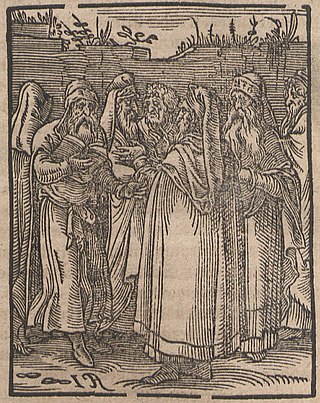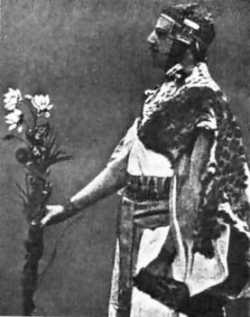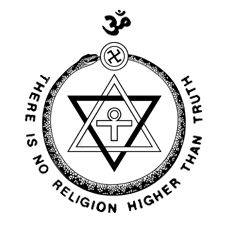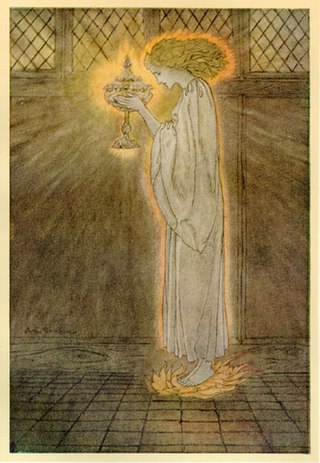
Kabbalah or Qabalah is an esoteric method, discipline and school of thought in Jewish mysticism. It forms the foundation of mystical religious interpretations within Judaism. A traditional Kabbalist is called a Mekubbal.
The occult is a category of esoteric or supernatural beliefs and practices which generally fall outside the scope of organized religion and science, encompassing phenomena involving a 'hidden' or 'secret' agency, such as magic and mysticism. It can also refer to paranormal ideas such as extra-sensory perception and parapsychology.

Christian theosophy, also known as Boehmian theosophy and theosophy, refers to a range of positions within Christianity that focus on the attainment of direct, unmediated knowledge of the nature of divinity and the origin and purpose of the universe. They have been characterized as mystical philosophies. Theosophy is considered part of Western esotericism, which believes that hidden knowledge or wisdom from the ancient past offers a path to illumination and salvation.
Emanationism is a theory in the cosmology or cosmogony of certain religious and philosophical systems, that posits the concept of emanation. According to this theory, emanation, from the Latin emanare meaning "to flow from" or "to pour forth or out of", is the mode by which all existing things are derived from a 'first reality', or first principle. In the emanationist concept all things are derived from this first reality or perfect God, by consecutive steps of degradation, to a lower degree of this first reality or God: at every consecutive step the emanating beings are less pure, less perfect, less divine. Emanationism posits a transcendent principle from which everything is derived, as opposed to creationism, that considers the universe to be created by a sentient God who is separate from creation, and to materialism, which posits no underlying subjective and/or ontological nature behind phenomena, all phenomena being considered immanent.

Isaac ben Solomon Luria Ashkenazi, commonly known in Jewish religious circles as Ha'ari, Ha'ari Hakadosh or Arizal, was a leading rabbi and Jewish mystic in the community of Safed in the Galilee region of Ottoman Syria, now Israel. He is considered the father of contemporary Kabbalah, his teachings being referred to as Lurianic Kabbalah.

Samuel Liddell MacGregor Mathers, born Samuel Liddell Mathers, was a British occultist and member of the S.R.I.A.. He is primarily known as one of the founders of the Hermetic Order of the Golden Dawn, a ceremonial magic order of which offshoots still exist. He became so synonymous with the order that Golden Dawn scholar Israel Regardie observed in retrospect that "the Golden Dawn was MacGregor Mathers."

Abraham ben Samuel Abulafia was the founder of the school of "Prophetic Kabbalah". He was born in Zaragoza, Spain, in 1240, and is assumed to have died sometime after 1291 following a stay on the small and windswept island of Comino.

Ascended masters in a number of movements in the theosophical tradition are held to be spiritually enlightened beings who in past incarnations were ordinary humans, but who have undergone a series of spiritual transformations originally called initiations.
Academic study of Jewish mysticism, especially since Gershom Scholem's Major Trends in Jewish Mysticism (1941), draws distinctions between different forms of mysticism which were practiced in different eras of Jewish history. Of these, Kabbalah, which emerged in 12th-century southwestern Europe, is the most well known, but it is not the only typological form, nor was it the first form which emerged. Among the previous forms were Merkabah mysticism, and Ashkenazi Hasidim around the time of the emergence of Kabbalah.

The pigpen cipher is a geometric simple substitution cipher, which exchanges letters for symbols which are fragments of a grid. The example key shows one way the letters can be assigned to the grid.

Moses ben Jacob Cordovero was a central figure in the historical development of Kabbalah, leader of a mystical school in 16th-century Safed, Israel. He is known by the acronym the Ramak.

The etheric body, ether-body, or æther body is a subtle body propounded in esoteric and occult philosophies as the first or lowest layer in the human energy field or aura. The etheric body is said to be in immediate contact with the physical body and to sustain it and connect it with "higher" bodies. It is also said to consist of a finer substance, more pure and composed of smaller particles, than the ordinary matter of the physical plane.

The Book of Dzyan is a reputedly ancient text of Tibetan origin. The Stanzas formed the basis for The Secret Doctrine (1888), one of the foundational works of the theosophical movement, by Helena Petrovna Blavatsky. The book has influenced writers in the ancient astronaut, occult and UFO communities. Historians and skeptics have dismissed the Book of Dzyan as a hoax and have accused Blavatsky of plagiarism.
De Arte Cabalistica is a 1517 text by the German Renaissance humanist scholar Johann Reuchlin, which deals with his thoughts on Kabbalah. In it, he puts forward the view that the theosophic philosophy of Kabbalah could be of great use in the defence of Christianity and the reconciliation of science with the mysteries of faith. It builds on his earlier work De Verbo Mirifico.

The Mathers table of Hebrew and "Chaldee" (Aramaic) letters is a tabular display of the pronunciation, appearance, numerical values, transliteration, names, and symbolism of the twenty-two letters of the Hebrew alphabet appearing in The Kabbalah Unveiled, S.L. MacGregor Mathers' late 19th century English translation of Kabbala Denudata, itself a Latin translation by Christian Knorr von Rosenroth of the Zohar, a primary Kabbalistic text.

Jewish meditation includes practices of settling the mind, introspection, visualization, emotional insight, contemplation of divine names, or concentration on philosophical, ethical or mystical ideas. Meditation may accompany unstructured, personal Jewish prayer, may be part of structured Jewish services, or may be separate from prayer practices. Jewish mystics have viewed meditation as leading to devekut. Hebrew terms for meditation include hitbodedut or hitbonenut/hisbonenus ("contemplation").
The primary texts of Kabbalah were allegedly once part of an ongoing oral tradition. The written texts are obscure and difficult for readers who are unfamiliar with Jewish spirituality which assumes extensive knowledge of the Tanakh, Midrash and halakha.
Pardes Rimonim is a primary text of Kabbalah composed in 1548 by the Jewish mystic Moses ben Jacob Cordovero in Safed, Galilee.
Z'ev ben Shimon Halevi was an author of books on the Toledano Tradition of Kabbalah, a teacher of the discipline, with a worldwide following, and a founding member of the Kabbalah Society.

Modern Theosophy is classified by prominent representatives of Western philosophy as a "pantheistic philosophical-religious system." Russian philosopher Vladimir Trefilov claimed that Blavatsky's doctrine was formed from the beginning as a synthesis of philosophical views and religious forms of the various ages and peoples with modern scientific ideas. Michael Wakoff, an author of The Routledge Encyclopedia of Philosophy, stated that Blavatskian Theosophy was based on Buddhist and Hindu philosophy, and fragments of the Western esotericism with using an "absolutist metaphysics." In The New Encyclopedia of Philosophy it is said that Blavatsky's Theosophy is an attempt to merge into a universal doctrine all religions by revealing their "common deep essence" and detection of "identity meanings of symbols," all philosophies, and all sciences.











